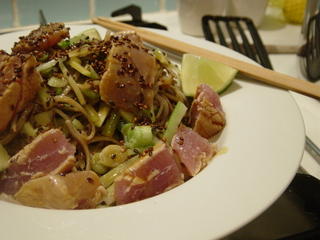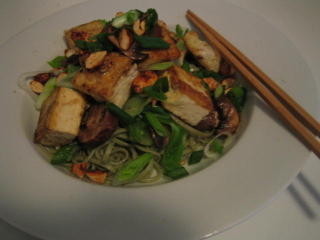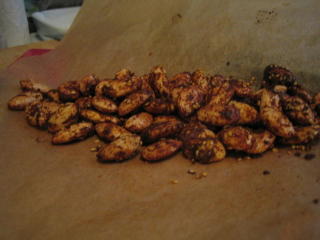
A mixed bag yesterday; signed a rental agreement for a flat in Granada, Spain… as pen was going to paper we heard that the sale of our flat in London had fallen through. Cool… that makes us something close to property tycoons. Firstly, because we have a nice weekend retreat from the city and secondly, because it will most likely wipe out all of our savings (maybe property typhoon is more appropriate).
To celebrate our new found lack of fortune, I cooked from Books for Cooks Vol. 4. This is the “glamorous” volume that we haven’t used too much. The recipe is originally from Kimiko Barber.
I took a trip to fishmongers on Northcote road to pick up the tuna for the recipe. The recipe calls for seared tuna, but I was in two minds given that I think tuna is best eaten raw. I am always intrigued as to whether there is a distinction between sashimi “worthy” tuna and the stuff that should only be cooked. The discussion with the fishmonger was of dubious merit:
steve: “do you reckon the tuna would be ok to have as sashimi?”
fishmonger: “eh?”
steve: “can I use it in sushi?”
fishmonger: “huh?”
steve: “like, uh, can I eat it raw?”
fishmonger: “yeah, sure… whatever”
steve: “how can you tell whether you can have the fish raw or not?”
fishmonger: [seemingly offended] “I’d never sell you bad fish”
steve: “yeah, yeah, I know you wouldn’t. Is there ever a time that you can’t eat tuna raw though?”
fishmonger: “eh, like when it ‘as gone off. It would ‘ave a ‘orrible smell and be all bluey black…”
steve: “ok, thanks”
We both left each other relieved to be out of the conversation.
Ingredients (serves 4)
4 tuna steaks (not the ‘orrible, smelly kind)
For the noodles
250 g buckwheat soba noodles
3 spring onions (scallions)*
½ cucumber
2 tbsp blackened sesame seeds
½ tsp toasted sesame seed oil
4 tuna steaks (not the ‘orrible, smelly kind)
For the noodles
250 g buckwheat soba noodles
3 spring onions (scallions)*
½ cucumber
2 tbsp blackened sesame seeds
½ tsp toasted sesame seed oil
1 lime
For the marinade
3 tbsp soy sauce
1 tbsp lime juice
1 tsp wasabi
For the marinade
3 tbsp soy sauce
1 tbsp lime juice
1 tsp wasabi
1 tsp sake or dry sherry
2 tsp sugar
2 tsp sugar

"pick up sticks" was my favourite game as a child. you can imagine how relieved I was to find out you could play it with dry soba noodles.
Bring a large pot of water to the boil. Put the noodles into the water. Bring back to the boil. Refresh with a glass of water. Books for Cooks explains that this cools the outside of the noodles and ensures that it doesn’t cook faster than the inside. Bring back to the boil and check the noodles are cooked through. If not, repeat the process. I was using some pretty old noodles (they were grey, so I assume they were soba), they had dried out a bit and required two cookings. Remove the noodles to a colander, rinse thoroughly with cold water. This will prevent further cooking. Put into a bowl with ½ tsp of the sesame oil. Cover and refrigerate.
Whisk the marinade ingredients together.
The fishmonger had left me in some doubt so I decided to err on the side of caution and sear the tuna. Heat a non-stick frying pan very hot. Sear on both sides (only 7-8 seconds per side). Remove to a shallow dish and pour the marinade over. Leave to cool.

You can use blackened sesame seeds or roast them yourself. I recommend that you roast them yourself. Heat the seeds in a frying pan. As they heat, their oils will come to the surface and they will start to clump together. Keep moving them, they give off an amazing smell. Wait until toasted and remove.
Peel the cucumber. Chop the peeled cucumber into matchsticks. Mix with the chopped scallions. Mix with majority of the sesame seeds. Add to the noodles.
For serving, pile the noodle salad up high. Use tongs. If you twist the tongs vertically into the bowl you’ll achieve good height of the salad. Chop the tuna into equal sizes and place on top of the salad. Spoon over the marinade. Garnish with remaining tsp of sesame seeds. The recipe suggested placing the cucumber peelings around the noodles, but this didn’t look great to me (I punished them by eating them). Put some lime wedges on the side.
It’s the perfect salad to calm the nerves and let you have a thought about innovative ways to take the burden of a London flat from you. Comments and financial recommendations welcome!
* For all those from overseas, spring onion is the UK name for green onions, which is the US name for scallions. Who is it hiding from???






